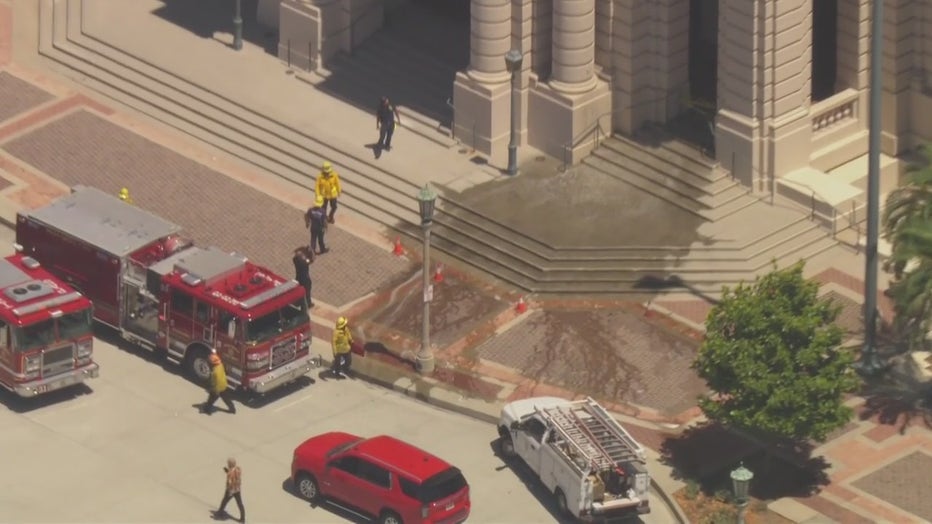Earthquake strikes Los Angeles near Highland Park
4.4-magnitude earthquake shakes Los Angeles
A preliminary 4.4-magnitude earthquake rattled Los Angeles, marking the second shake in the last week.
LOS ANGELES - Did you feel it?
A strong earthquake struck Los Angeles, centered near the Highland Park area, Monday afternoon.
According to the U.S. Geological Survey, the quake hit around 12:20 p.m. and was centered two miles south-southeast of Highland Park. It was first reported to have originated in South Pasadena as a 4.7, but was later reduced to 4.4. The quake had a recorded depth of 12.1 km.
Earthquake rattles LA-area
A strong 4.4-magnitude earthquake struck Los Angeles, centered near the Highland Park area, Monday afternoon.
Widespread shaking was reported across a wide area spanning most of Los Angeles County and stretching into Orange and Riverside counties. What residents described as a "rolling sensation" lasted for several seconds.
Pasadena city employee describes 4.4 earthquake
FOX 11 spoke to a city employee who was inside Pasadena City Hall when a 4.4 magnitude earthquake struck. Everyone in the building was evacuated; at least one person was stuck inside an elevator.
The National Weather Service said a tsunami was not expected.
The Los Angeles Fire Department immediately went into "earthquake mode," sending crews out across the city to examine critical infrastructure and check for damage to structures, buildings and other facilities. About an hour later, officials said they found no significant infrastructure damage or injuries."

Shaking from Monday's earthquake caused a pipe to burst at Pasadena City Hall. (FOX 11)
How prep for California earthquakes
With two earthquakes in about a week, Californians are being reminded of the importance of making sure you and your family are ready before "the big one" hits Southern California.
SkyFOX was over the scene at Pasadena City Hall, where there was an apparent water line ruptured. Water could be seen pouring out of a pipe on the outside of the building, and yellow caution tape was put up around parts of the exterior. Around 1:15 p.m., those who evacuated the building were seen re-entering.
Earthquake: LA City Fire reports no damage
Margaret Stewart with LA City Fire Department told FOX 11 there was no major damages reported.
In an update, LA County Supervisor Holly J. Mitchell said there was no major damage or road closures reported.
As crews continued to assess for damage, Metro also alerted riders it would be slowing all trains as they perform inspections. Just after 1 p.m., Metro said in an update that all rail lines were resuming normal service. Metro reported no damages and no injuries.
During a briefing held following the quake, earthquake expert Lucy Jones said the earthquake appeared to be based on the same group of faults that created the 1987 Whittier Narrows quake.
SUGGESTED:
- Prelim. 5.2-magnitude earthquake, followed by at least 60 aftershocks in Southern California
- More than 60 aftershocks rattle Southern California following 5.2-magnitude earthquake
- Customers run for cover as earthquake rattles SoCal
"There have been others in the past," Jones said. "In 1989 we had a pair of four-and-a-half's there were also in the system that were just a half-hour apart. There have been plenty of small ones over the years that are also within this."
"Imaging shows us several faults that stack on top of each other, none of which come to the surface. The Puente Hills thrust and Elysian Park thrust are names given to that stack," Jones added.
She recalled experiencing the Mexico City earthquake in 2017, noting that the biggest difference between that one and today's was the duration of the quake.
"The duration of that was just a lot longer, the whole building shook. And so it was a very noticeable difference immediately, that this one just ended much, much quicker."
It struck on the first school day for the Los Angeles Unified School District. At least one high school, John Marshall in Los Feliz, alerted parents that they had evacuated the buildings to check for damage, but didn’t see any immediately.
LAUSD Superintendent Alberto Carvalho said they did not receive any reports of injuries or significant damage to any of their facilities.
SUGGESTED: LAUSD returns to school Monday for 2024-25 school year
This comes less than a week after a 5.2-magnitude earthquake struck the Central Valley, near Bakersfield. Just seconds after the first quake, two aftershocks were reported in Lamont and four additional aftershocks struck in the Grapevine area. The aftershocks were reported between 9:10 p.m. and 9:46 p.m. with preliminary magnitudes ranging from 2.5 to 4.5.
Nearly 24 hours after the first earthquake hit, the USGS detected more than 60 aftershocks within 20 miles of the epicenter.
For more information on earthquake preparedness, tap or click here.
City News Service contributed to this report.

